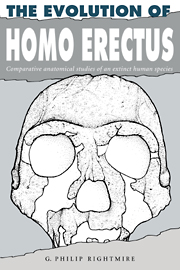Book contents
- Frontmatter
- Contents
- Preface
- 1 Introduction
- 2 Homo erectus in the Far East
- 3 Homo erectus at Olduvai Gorge
- 4 Discoveries from the Turkana basin and other localities in sub-Saharan Africa
- 5 Northwest Africa
- 6 Comparisons of African hominids with Asian Homo erectus
- 7 Homo erectus as a paleospecies
- 8 The transition to more modern forms
- 9 Summary and prospects for further research
- References
- Author index
- Subject index
1 - Introduction
Published online by Cambridge University Press: 14 October 2009
- Frontmatter
- Contents
- Preface
- 1 Introduction
- 2 Homo erectus in the Far East
- 3 Homo erectus at Olduvai Gorge
- 4 Discoveries from the Turkana basin and other localities in sub-Saharan Africa
- 5 Northwest Africa
- 6 Comparisons of African hominids with Asian Homo erectus
- 7 Homo erectus as a paleospecies
- 8 The transition to more modern forms
- 9 Summary and prospects for further research
- References
- Author index
- Subject index
Summary
Following the discoveries of several Neanderthals in Europe, traces of a more archaic kind of human were uncovered in Asia, toward the close of the last century. These fossils were found at Trinil in Java by Eugene Dubois, who described them as Pithecanthropus erectus. Later in the 1920s, more human remains along with animal bones and stone artifacts were excavated from cave deposits at Zhoukoudian in China. On the strength of a few isolated teeth, this new hominid was named Sinanthropus pekinensis. Additional teeth, skulls and post-cranial pieces from Zhoukoudian were all lost during World War II, as is well known. It is most fortunate that this material had been described by the anatomist Franz Weidenreich, whose famous monographs were published between 1936 and 1943 by the Geological Survey of China.
The fossils from Java and China are now referred to the species Homo erectus. Since the war, many more specimens have come to light, in Africa as well as Asia. The hominids themselves have been studied in detail, and much effort has been put toward obtaining stratigraphic and paleoecological information from the more important sites. Better dates are becoming available. Lately, Homo erectus has become a topic of particular interest to paleoanthropologists, and new questions have been asked. Some of these concern the geographic distribution of the taxon and whether it should be recognized in Europe, or for that matter anywhere outside of the Far East. Others address continuity and change in the evolution of the species.
- Type
- Chapter
- Information
- The Evolution of Homo ErectusComparative Anatomical Studies of an Extinct Human Species, pp. 1 - 9Publisher: Cambridge University PressPrint publication year: 1990

